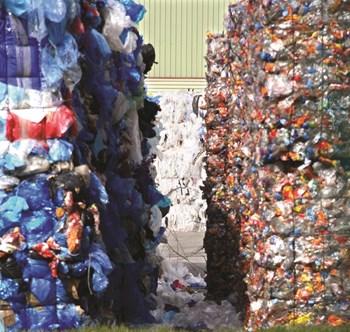
Not so long ago, trash was nothing more than “used up stuff” and there was little of it. Our grandparents made use of burn-barrels and bottle dumps in the back yard. But that was before packaging became a major business in and of itself. Today, solid waste disposal represents a major line item in community budgets, even as it has spawned multiple industries, some of which generate energy or recycle to contribute “raw materials” to manufacturing.
While the fans of recycling would love to envision a world in which our throw-aways become a valuable resource, that goal is far off—if it’s even ever possible. Paying someone to take trash away seems to be an unwavering reality. But the good news is that trash removal costs are slowly diminishing. The reasons for this trend are many, ranging from the evolution of recycling to a slow economy.
Condo associations are in a unique position to speed up this trend within their own communities—maybe even getting trash removal to pay for itself, as “pay-as-you-throw” communities are doing.
State Requirements Promote
New Markets for Trash
One company that has been weathering these trash/recycling trends is E.L. Harvey & Sons, Inc. of Westborough, Massachusetts, which services eastern Massachusetts and southern New Hampshire. “We are basically a recycling company who will also pick up trash,” states John Delaney, sales supervisor.
Nationwide, the future of waste management points to more and more recycling, made much easier with the advent of single-stream processing, which no longer requires sorting recyclable items. Single-stream allows consumers to bundle almost all clean waste materials together: plastics, glass, paper, cardboard and metal containers. “Massachusetts requires recycling of almost everything,” Delaney notes. To meet this trend, E.L. Harvey has constructed its own 80,000-square-foot facility in Hopkinton and Westborough. “It’s on 95 acres of land that the firm has owned for years. It’s a fully integrated, single-stream recycling plant. We went through a five year process to get permitted” with local boards and state agencies.
“We have nursed this project through the economic slump,” reports Delaney, “Some abutters had legitimate concerns [and] needed assurance that they would not be impacted negatively. They were worried about potential truck traffic, noise and odors. In the long run, after this [permitting] process, you wind up with a better product and service…”
“We had to be better, smarter… and come out of it stronger,” he recalls. “You come out of this process with your neighbors knowing you better; knowing the company better. We have a long history in Westborough… this was originally a dairy farm,” he adds with a chuckle. “We’ve only been around for 101 years.”
Use Cooperative Relationships
with Contractors
To lower trash costs, he points out that any association can take advantage of a “group rate” for trash hauling, even in a townhouse setup with curbside pickup. “Some condo communities prefer curbside service and don’t need a central dumpster… Sometimes there’s no room for a dumpster, but you can still use that volume buying power by having central billing [by the association] which can save up to 25 percent.”
The business community, he adds, “is farther ahead with recycling because they see waste removal as affecting their bottom line. For instance, a recent sales pitch from Subaru is, ‘zero impact on landfills’. Community associations have a similar situation… they’re spending their own money. Some of the biggest apartment management companies are addressing it as a major operating cost.”
For his firm, he says, “recycling is about half the cost of trash [removal] per cubic yard. Now, with single-stream recycling, you’re removing 35–50 percent of the total trash that has to be hauled away. Each state has its own trash issues, but the market is moving toward single-stream which is becoming cheaper than the price of trash disposal. Plus, we’re creating less trash in general. Society as a whole is becoming more aware… of how we produce packaging and how we ship things.”
“In Massachusetts, the DEP is moving away from the use of landfills, and state law lists all the materials no longer allowed in landfills… these are the things that get recycled.” With landfills getting capped, Delaney explains, “Most trash in Massachusetts goes to ‘trash-to-energy’ facilities which burn trash to generate electrical power. These are all privately owned,” he notes, like the Wheelabrator plant in Millbury, owned by Waste Management.
“By contrast,” he adds, “in Connecticut, the state owns or controls all trash-to-energy plants, and there are no privately-owned landfills left—the plants take 90 percent of the trash that used to go to landfills. In Rhode island, the state owns one landfill.”
Delaney explains how “single-stream” works, “The mixed materials go down a conveyor belt. In older plants, the paper and fiber is manually pulled out. Newer plants, however, are all automated… they’re the wave of the future. The materials are subjected to different stimuli and they separate out, whether it’s with air currents or magnetic fields. For instance, glass is heavy and settles to the bottom. Plastics get turned into pellets. Once separated, different mills buy the materials and create new products. Ground glass has other uses; mixed with gravel and fill, it can be used in road-base construction.”
Getting on Board with Recycling
Economics and land availability factor into trash disposal facilities. This means that different approaches to recycling may be found in other New England states. In Maine, says John James, environmental specialist with the Department of Environmental Protection, “We have recycling goals, and cities and towns are required to report their progress in achieving them. Our landfills only prohibit municipal solid waste that may be hazardous, such as mercury products.” While Maine has a bottle deposit fee that is much broader than neighboring states, and includes water and juice containers, James notes, “It’s not illegal to dispose of returnable [deposit] containers into the trash stream.”
Laws are stricter in more densely-populated areas, such as Connecticut, where “everyone wants to recycle,” reports Paul Nonnenmacher, director of public affairs for the Connecticut Resources Recovery Authority. The CRRA operates two of the state’s six trash-to-energy plants, and admits that “recycling will have to go a long way to make any impact on trash volume, even though the more [material] that’s recycled, the less trash will cost.”
Nonnenmacher states, “Trash volume is an indicator of economic activity” and points out that after the downturn in 2008, volumes went down considerably, starting with construction waste. With electronic media, “manufacture of newsprint, and paper in general, has diminished. Packaging is also… much different than it was a few years ago. You see much less boxing of items, and plastic clamshells. Also, manufacturers are making their packages lighter, like water bottles and beverage cans getting thinner.”
Helping the commodities market for recycled materials in Connecticut and other states has been legislative action that mandates a certain percentage of recycled content, as, for instance, in paper production.
Maybe more importantly, Nonnenmacher describes how “people’s habits have changed with more materials allowed as recycled, and the advent of single-stream disposal—this has changed behavior.”
Turning Trash Around
In Massachusetts, there are no new landfills or trash-to-energy facilities being proposed because the industry “does not see a need for more [processing/disposal] sites,” reports Joe Ferson, spokesman for Massachusetts DEP. “Many [of these facilities] are currently taking less waste than they are permitted for.” The state’s master plan for solid waste management sets goals and timelines for converting most trash to recycling.
In municipalities, or condo associations, where trash haulers are contracted by the entire community, there may not be much practical incentive for individual homeowners to separate out the recyclables from the rest of the trash—it all gets picked up regardless of which bin it’s in.
To create an incentive, Ferson points out that “over 130 cities and towns—and that number is increasing—use the ‘pay-as-you-throw’ model.” In the version used by the city of Worcester, which has been a success for many years, the city supplies a number of retail outlets with yellow plastic trash bags which residents purchase for about one dollar. There is no mark-up for the vendor, and no tax involved in the sales.
Residents are given a specific list of paper, plastic, glass and metal items that can go in the recycling bins—they must be clean and food-free. Everything else goes into the yellow bags, and the city provides curbside pickup of bins and bags. A similar system could be customized for condo communities, and trash bag sales could become a revenue source in the association budget, or a credit for unit owners to offset fees.
Another incentive model, states Ferson, “is where the community can limit the number of trash barrels that people can put out.” And in Rhode Island, the Town of North Providence will not collect garbage from residents who do not recycle—so curbside, the green bins must accompany all trash barrels.
“The pay-as-you-throw model,” says CRRA’s Nonnenmacher, “is theoretically the best system, [but] it may seem impractical to some municipalities… [who] may not want to get involved in retailing the bags. In Worcester, someone must have had the political will to just do it.”
The success of the yellow trash bags in Worcester has seemingly created a recycling culture that infuses local condo communities that do not have curbside pickup. Nancy Day, property manager with Salisbury Management of Boylston, Massachusetts, describes two Worcester properties she handles with multi-unit buildings. “Our unit owners and residents are given notices about the recycling program…. And it’s part of their move-in instructions. Both communities have dumpsters on site, plus recycling bins which the vendor provides, and there’s also a recycling center.” She contends that residents are good about recycling and it seemed to have increased in popularity after single-stream was introduced.
As legislative bodies in many states continue to rally for more recycling, managers and boards in condo communities will face increasing pressure to move away from trash and toward less-costly and more “green” methods of waste disposal—ultimately a win-win situation. While a cultural shift toward recycling may be inevitable, it’s been a slow journey. Using incentives that are available—such as the pay-as-you-throw model—may move a community toward more immediate results.
Marie Auger is a Massachusetts freelance writer and a frequent contributor to New England Condominium






Leave a Comment